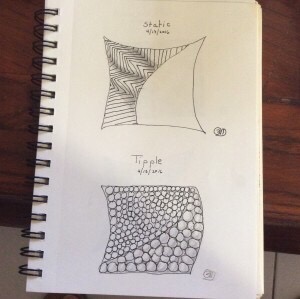Earlier this week, on the Zentangle® Mosaic® app, founder Maria Thomas shared one of her first tangling pieces from very early in The Zentangle Method®’s history. She encouraged us to share our firsts.
As I read through descriptions of uploaded first works, I marveled at how many tanglers were introduced to Zentangle through use of the book One Zentangle a Day, by Beckah Krahula. Individuals who had not been able to locate a CZT (that’s Certified Zentangle Teacher) began their tangling journey using that book One Zentangle a Day was published in 2012, four years before the more comprehensive Zentangle Primer, Vol. 1 came out. Although Suzanne McNeil had been publishing thin workbook-style books for several years by then, it did not take a rocket scientist’s math abilities to realize that Krahula’s book was more cost-efficient and comprehensive than twelve workbook volumes. Before spending $50 on the official Zentangle kit (available from the Zentangle.com site or from any CZT) and, for the past year, another $50 on the Primer, so many of us took the less expensive introductory experience of purchasing One Zentangle and a stack of inexpensive card stock paper tiles by Peter Pauper Press (probably all purchased via Amazon, too!). Or we used sketchbooks in lieu of tiles. This way, if we didn’t like tangling, we spent less than $30 for book and tools rather than $100 or more to get started. Not one of us regrets having spent that $100 later, though, because the tangling journey made us feel good, and we needed more.
My tangling journey began 15 months ago, with One Zentangle a Day and a sketch book that had many of my traditional drawing attempts in its first half. I worked almost exclusively in the journal for several weeks, mostly because I lacked the confidence to ruin even a cheap tile. Sometimes, I drew  3.5-inch squares to simulate tiles. More often, I simply drew a square that was big enough to tangle in, but was either larger or smaller than an actual tangling tile. Perhaps I was deciding whether I liked tangling, or maybe I was sticking to the sketchbook because I needed the sense of familiarity and security of a well-used surface. It took a while before I started using the inexpensive tiles.
3.5-inch squares to simulate tiles. More often, I simply drew a square that was big enough to tangle in, but was either larger or smaller than an actual tangling tile. Perhaps I was deciding whether I liked tangling, or maybe I was sticking to the sketchbook because I needed the sense of familiarity and security of a well-used surface. It took a while before I started using the inexpensive tiles.
Much of my tangling was originally done in pencil–just in case I wanted to erase, even though we don’t erase in tangling. Then I moved on to more complex tangling as I learned more patterns and came up with more strings. Gradually, my work improved and I out-grew One Zentangle a Day.
That’s when I decided to invest in the Zentangle Kit, the Primer, and finally the Zentangle Mosaic app. Following the lessons in the Primer and getting insight and inspiration from fellow tanglers on Mosaic, I kept tangling and found my art–and my ability to meditate–growing, expanding, evolving. By then, I had also decided that I needed to attend the Zentangle teacher certification Seminar, if for no other reasons than to attend a formal class, and to legitimately spread the love of tangling to the island’s residents so I wouldn’t have to tangle alone.
Maria Thomas’ challenge on the Mosaic app opened so many opportunities to share where many tanglers started, and why we started. Some people took up tangling because they were established artists wanting to learn a new technique. Many started their Zentangle journey because of a major life change–the loss of a loved one, a move to a very different environment, retirement. Still others came across the Zentangle Method when they were searching for a form of meditation that didn’t force physical stillness. A few were introduced to tangling by a close friend. Some simply stumbled across Zentangle on the internet and thought it was pretty. Most started tangling because of several of these reasons, plus others. But we all started somewhere, fell in love with tangling, and continued to grow through certification seminars or various local tangling workshops.
The humble beginnings project got many of us communicating and sharing how the Zentangle Method has helped us personally. Both on this blog and on another blog site (Write of Passage, or dremiller.com), I have shared both why I tangle and what my experiences have been. Among the ways Zentangle has helped me personally is calming my mind, helping me learn (or re-learn) to focus on something, relieving physical and mental tension and anxiety; and providing meditative opportunities to examine my past, including behaviors, and to brain-storm the possible impacts of important decisions. Meditation has helped me explore myself in many ways, with the topic of exploration showing up often in my tangled works.
Why do you tangle? How did you get started? If you have been tangling a while, how has the Zentangle Method helped you with your life and your art? How has your art changed?
Leave a comment to this post and share your tangling journey!
Until next time, Happy Tangling!





